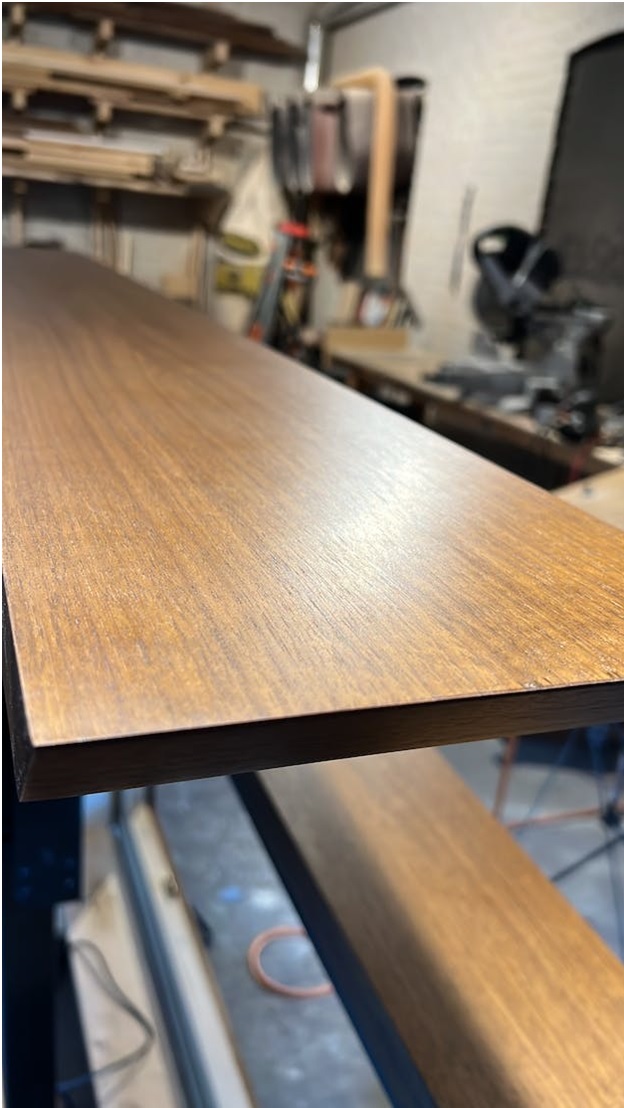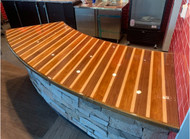Veneer Backer Types (Plus Application Tips)
Mar 24th 2023
Oakwood Veneer is proud to offer not only a huge collection of domestic and exotic wood veneer species, but a variety of practical veneer backer types as well.
Before you purchase your next order of oak, ash, or beech veneer sheets, consider the backing type - we offer the following.
(Note: for paper-backed veneers, the “mil” designation refers to the thickness of the backing only and not the entire veneer sheet; that varies according to species.)
BFV (Bubble-Free Veneer)
Our 22 mil BFV, or bubble-free veneer backing, has been extensively tested for 30 years and is a flexible backer with superior characteristics. Most of our species are available with it by special order
Each bubble-free veneer sheet has 22.2 mils of backing and consists of 3 layers. The first layer is the wood veneer itself, under which there are two layers of acrylic adhesive and paper. These two layers provide a double moisture barrier.
Bubble-free veneer is flexible and stable, and has a built-in vapor barrier that prevents stain, finish and other moisture from reaching the adhesive you use to affix the veneer sheet.
10 Mil Paper Backer
10 mil paper backer is our original backing, with a single 10 mil of paper backing on each sheet. The 10 mil backing is suitable for a wide range of projects, especially those in which the substrate surface is not perfectly flat, as 10 mil paper backing is highly flexible.
10 mil backed veneer is also popular because it is affordable. This type of backer is generally most suitable for pressing applications and works well with PVA and cold-press glues.
W.O.W. (Wood On Wood, AKA 2 Ply)
Wood on wood, or W.O.W., backing, offers better durability than paper-backed veneer, while still retaining a good degree of flexibility. Our wood-on-wood veneer contains a paperback layer in the middle, covered by a flexible wood backer. The wood backing layer is perpendicular to the face veneer for added stability of each sheet. Wood on wood veneer is like a very thin sheet of plywood.
Phenolic Backed Laminate
We also carry veneer sheets with phenolic-backed laminate, Phenolic resin is fairly strong, but not quite as flexible as paper-backed veneer. This backer provides excellent resistance to moisture, heat, and chemical attack. This type of backing is suitable where extra durability and stability are necessary and it performs well on substrates that are less than ideal. The installation of phenolic veneer is similar to that of plastic laminate.
PSA (Pressure-Sensitive Adhesive) Adhesive Backing by 3M
Oakwood Veneer also sells custom 3M PSA (pressure-sensitive adhesive) backed veneer sheets also known as peel and stick and sticky-back. These sheets are made-to-order (and therefore not refundable) so contact us at 800-426-6018 if you have any questions.
Wood Veneer Application Tips
Regardless of the type of wood veneer backing you choose for the job, there are some good practices that you should observe across the board.
Properly Prepare the Substrate
No veneer project will be successful if you do not properly prepare the substrate. All substrates should be sanded with a low grit 60 to 80 grit sandpaper. This will help improve the surface texture of the substrate. For porous substrates, like MDF, particle board, or plywood, this will increase the surface area to improve adhesive absorption and bondage.
Also, you want to make sure that the surface to which you apply the veneer is as flat as possible. For instance, if you apply veneer over plywood, you want the face to be as flat as possible because any waves or depressions will telegraph through the substrate.
Use a Stiff Scraper
In order to ensure that the veneer lies flat and properly bonds with the substrate you must use a very stiff scraper. A piece of wood, 12”x6”, makes a great scraper. Lightly sand one edge of the piece or wood to create a slight radius (the sharper the better) and use both hands to press the wood scraper along like a squeegee to press the veneer into the substrate to the finished veneer.
Use an Iron to Help Combat Bubbles
So long as you have used adequate contact cement, a warm iron can be used to reactivate the cement so it can be pressed down. Use a piece of Kraft paper between the iron and the veneer surface to protect the veneer finish; then use the wooden scraper to press down the veneer as detailed above once you have warmed the surface to reactivate the cement.
Check for Imperfections with a Light

A bright light can be used to check for bubbles and other imperfections in the veneer surface that you wouldn’t otherwise be able to see or feel. Shine the light across the veneer sheet at a few different angles to see if there are any bubbles or depressions telegraphing through the veneer surface.
Use a Very Sharp Knife to Trim the Veneer
If using a knife to trim the veneer, use only a very sharp knife or razor blade as this will achieve a clean cut and will not tear the veneer. Alternatively, you can use a flush-cutting router bit around the edges to complete the fit and finish.
Sand Carefully
Veneer sheets can be sanded and stained or finished according to the needs of the user. However, it’s important to proceed carefully with finish sanding to clean up at minor imperfections.
Ash, Oak, Cherry, and Beech Veneer Sheets and Panels
Ready to embark on a project using our wood veneer sheets or panels? We carry a wide range of domestic and exotic hardwoods including but not limited to zebra wood, oak, cherry, bamboo, ash, and beech veneer sheets and panels. All veneer sheets are available with different backing options (including custom peel-and-stick backing).
For more information on wood veneer backing options or advice on how to apply, get in touch with us at 800-426-6018 or send us a message at Info@OakwoodVeneer.com.
